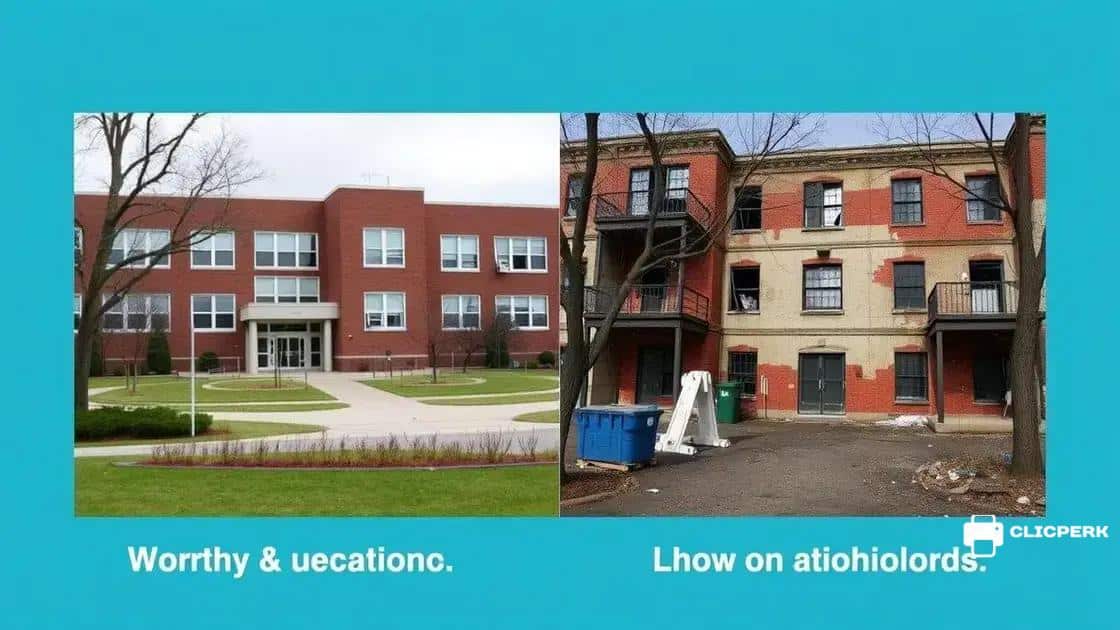Debates over legal access to public education

Debates over legal access to public education focus on equity, funding disparities, and the need for comprehensive policies that ensure all students receive equal opportunities regardless of their background.
Debates over legal access to public education are becoming increasingly relevant in today’s society. How do various laws shape the experiences of students across different regions? Let’s dive into this complex issue.
Understanding the legal framework of public education
Understanding the legal framework of public education is essential for grasping how schools operate. Laws govern everything from funding to students’ rights, shaping the landscape of education.
Various laws, such as the Elementary and Secondary Education Act, aim to provide support for students and ensure equitable access. These laws lay the groundwork for what students can expect in their educational journey.
The Role of Local, State, and Federal Laws
At different levels of government, laws affect how education is delivered. For example, state laws might dictate how diplomas are awarded or the qualifications required for teachers.
- Local laws can define school district boundaries.
- Federal laws ensure that students with disabilities receive appropriate services.
- State legislation influences curriculum standards and assessment practices.
Moreover, the Every Student Succeeds Act emphasizes accountability, allowing states to create their own standards for student performance. This law replaced No Child Left Behind and provides more flexibility to local districts.
Impact on Student Rights
Legal frameworks also play a significant role in protecting student rights. The First Amendment, for example, guarantees students’ freedom of expression in school settings. However, this right has limits when it interferes with the educational process.
Furthermore, laws like the Family Educational Rights and Privacy Act (FERPA) assure that students’ educational records are kept confidential. Understanding these rights can empower students and parents alike to advocate for better educational experiences.
As we explore the complexities of laws affecting public education, it’s clear that an insightful understanding of these legal frameworks can impact students’ educational outcomes. By being informed, families and communities can work together to challenge disparities and uphold equal access to quality education for all.
Current controversies surrounding access to public education
Current controversies surrounding access to public education are at the forefront of many discussions today. Various issues challenge the belief that every student should have the same educational opportunities, regardless of their background.
One major controversy involves funding discrepancies between wealthy and low-income school districts. Often, schools in affluent areas receive more financial support, leaving those in underfunded communities struggling to provide basic resources.
Key Issues Affecting Access
These funding disparities lead to several key issues that affect students:
- The availability of qualified teachers.
- Access to advanced placement and extracurricular programs.
- Quality of facilities and learning materials.
Moreover, some states face legal battles over whether residential segregation impacts educational equity. Lawsuits aim to address whether students should be funded based on their zip codes.
The Role of Policy Changes
Policy changes can significantly influence public education access. For instance, initiatives to improve charter school systems have sparked debates about whether they offer better options or take resources away from traditional public schools.
Comparing the current policies of various states reveals how much variance exists in the vision for public education. Some embrace inclusive policies to ensure that undocumented students and those with disabilities have equal access, while others restrict access.
Access to public education is also influenced by factors such as housing policies. Students living in areas with strict zoning laws may find it hard to attend better public schools nearby. Understanding these complexities helps shine a light on the need for comprehensive reforms.
Case studies highlighting disparities in public education access

Case studies highlighting disparities in public education access reveal significant gaps that exist among different communities. These examples provide insight into how location, funding, and policies can lead to unequal educational opportunities.
One notable case study comes from New York City, where funding differences create stark contrasts between schools in affluent neighborhoods and those in lower-income areas. Schools in wealthier districts often have more resources, better facilities, and higher salaries for teachers.
Comparative Analysis of School Districts
For instance, a comparative analysis of schools in the Bronx versus the Upper East Side shows:
- Schools in the Bronx receive significantly less funding per student.
- Teacher retention rates are lower in underfunded schools due to lack of support.
- Students in wealthier areas have access to a wider range of extracurricular activities.
Another impactful case study is in California, where Proposition 30 aimed to increase funding for schools but faced opposition. The disparities between urban and rural schools raise questions about how funding decisions are made and who gets affected by them.
Impacts on Student Success
These case studies illustrate that access to public education is not equal for every student. Factors such as funding, community support, and educational policies significantly impact student achievement.
For example, schools with high levels of community engagement tend to have better outcomes. In contrast, schools that lack this support struggle to meet basic educational needs.
The data from these case studies underline the importance of recognizing systemic issues that contribute to educational disparities. They serve as a call to action for policymakers and communities to work toward creating more equitable education systems.
The role of government in ensuring equitable education
The role of government in ensuring equitable education is crucial for providing all students with the same opportunities. Governments at the local, state, and federal levels create policies that impact how education is delivered.
One major responsibility of the government is to allocate funding fairly across school districts. This funding is essential for resources, technology, and qualified teachers. When funding is unequal, disparities arise, limiting the potential of students from underfunded areas.
Legislation and Policy Initiatives
Various legislations aim to address educational equity. For instance, the Elementary and Secondary Education Act provides federal funding to schools in low-income areas. This funding helps to level the playing field.
- Schools receiving Title I funding often have additional resources for programs and staff.
- Policy initiatives like school choice aim to give families options, though they can also lead to further disparities.
- Special education laws ensure that students with disabilities are provided appropriate resources and support.
State governments also play a key role in education equity by setting curriculum standards and accountability measures. However, these standards can vary widely, affecting how students are prepared for the future.
Challenges to Equity
Despite efforts to improve equity, significant challenges remain. Factors like poverty, housing instability, and systemic racism continue to impact education access. For example, children in marginalized communities often face barriers that their peers do not.
Community engagement is another important factor. When parents and local organizations collaborate with schools, they can advocate for resources and support. This collaboration can influence government policies, ensuring they are more inclusive and better serve diverse populations.
Recognizing the government’s pivotal role in ensuring equitable education is essential. As new policies and initiatives are developed, it’s crucial to focus on creating an educational landscape where every student can thrive.
Future directions for public education policy and access
Future directions for public education policy and access are shaped by ongoing debates about equity and quality. As society evolves, so do the challenges and opportunities that impact education.
One major area of focus is the incorporation of technology into learning environments. With the rise of online education, schools are exploring how to effectively blend in-person and virtual learning. This hybrid model can enhance access for students who may struggle to attend traditional classrooms.
Emphasis on Equity
Future policies must prioritize equity to ensure that all students have fair access to quality education. This involves addressing the needs of underrepresented populations, including low-income families and students of color.
- Expanding resources for schools in underserved communities.
- Implementing mentorship programs to support at-risk students.
- Fostering partnerships between schools and local organizations for outreach and support.
Another direction focuses on mental health and wellness in schools. As awareness of mental health issues rises, policies that support mental health resources can help create a more conducive learning environment.
Innovative Funding Solutions
Budget allocations will also play a critical role in shaping the future. Innovative funding solutions, such as community-based initiatives and public-private partnerships, can help close the gaps in educational access.
Research shows that investing in education yields long-term benefits, both for individuals and society. By creating a budget that reflects the need for equitable resources, policymakers can help ensure that every student has the opportunity to succeed.
Collaboration among government entities, educators, and communities will be essential in pushing these policies forward. By working together, stakeholders can create an education system that not only meets current needs but is also adaptable for future challenges.
In this exploration of public education, we’ve highlighted the importance of equitable access and future policy directions. Addressing disparities is essential for ensuring all students receive the education they deserve. By focusing on funding, innovative solutions, and community involvement, we can create a more inclusive educational landscape. Together, we can push for reforms that not only meet today’s needs but also prepare future generations for success.
FAQ – Frequently Asked Questions about Public Education Policy
What are the key issues affecting access to public education?
Key issues include funding disparities, housing instability, and the lack of resources in underserved communities.
How can technology improve public education?
Technology can enhance learning through blended and online education, making it more accessible for students.
What role do communities play in education equity?
Communities can advocate for resources, influence local policies, and support schools through partnerships and involvement.
What is the importance of equitable education policy?
Equitable education policy ensures that all students have the same opportunities to succeed, regardless of their background.





